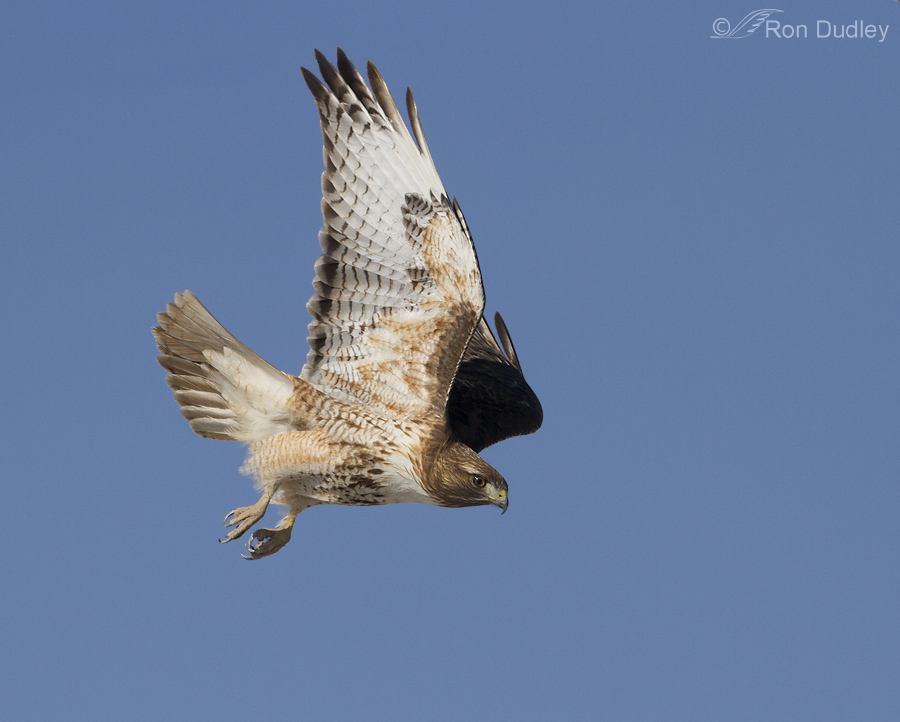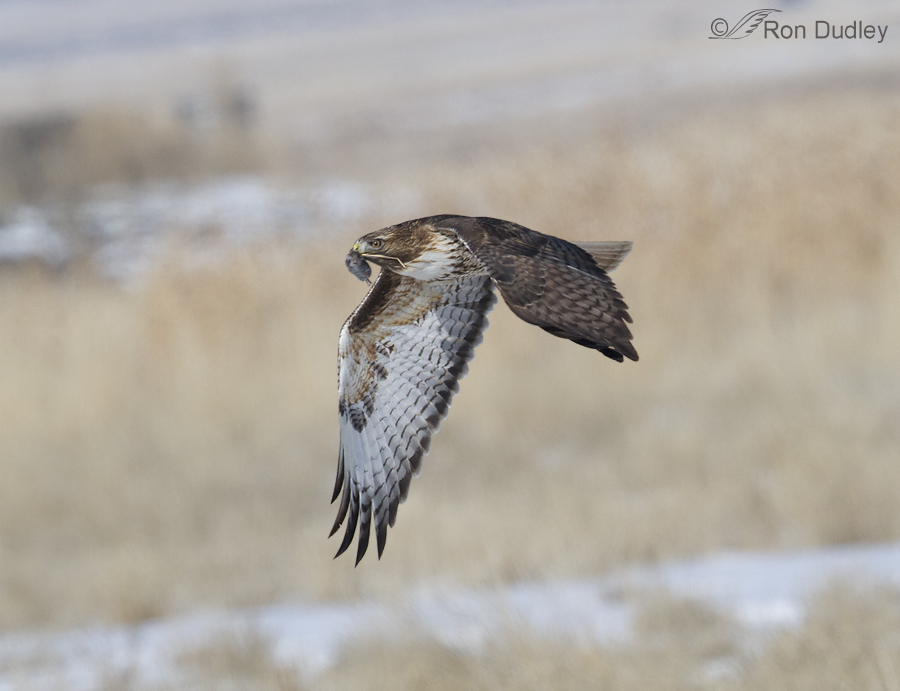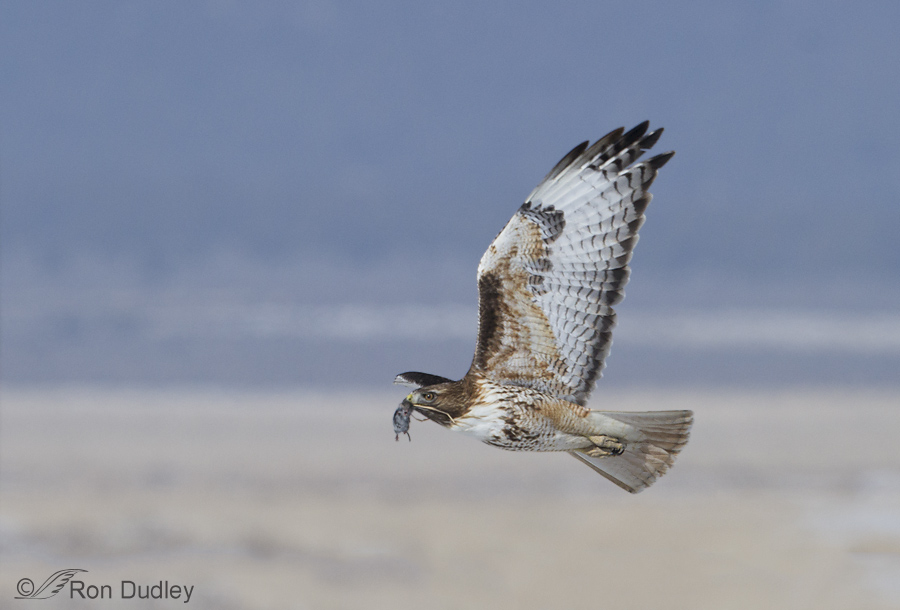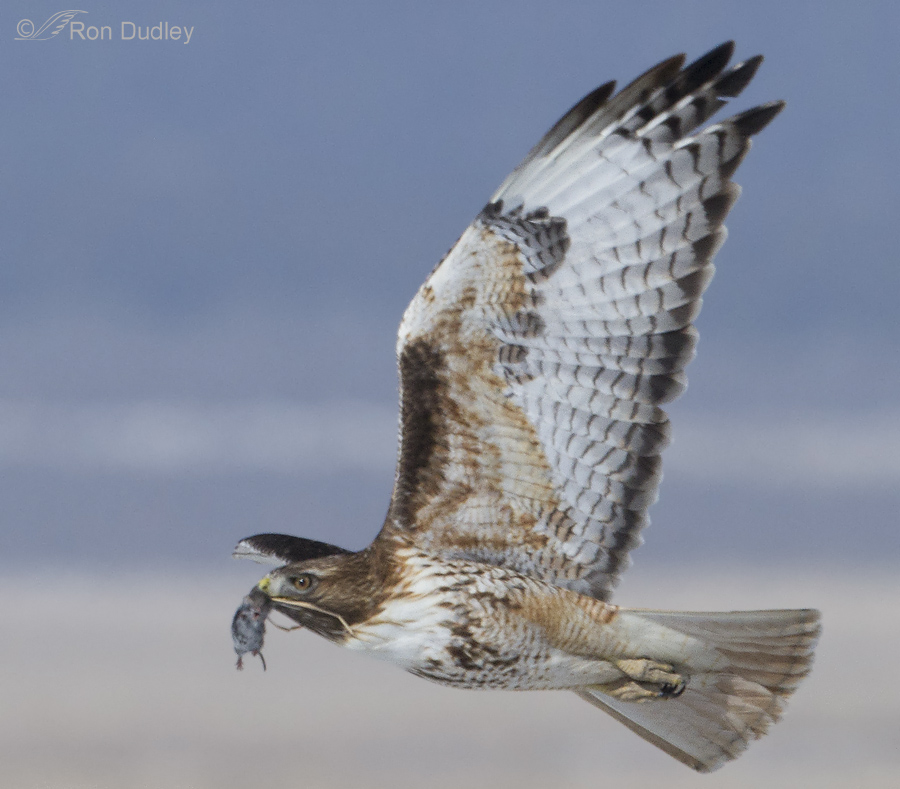It’s not often that I catch a Red-tailed Hawk in flight with a vole in its beak.

1/2500, f/8, ISO 500, Canon 7D, 500 f/4 II, wire removed, not baited, set up or called in
A few weeks ago (January 21) I was attempting flight shots of this adult as it hunted from power poles in Tooele County. When the bird launched after prey (voles) its angle of attack was usually fairly steep, as it is here. The attempts at prey were most often unsuccessful so it would come back to the same pole or a different one down the line to resume its hunting.

1/3200, f/8, ISO 500, Canon 7D, 500 f/4 II, not baited, set up or called in
But 15 minutes after the previous photo was taken the bird caught a vole out in the snow and grass and as it returned to a different power pole to enjoy breakfast I was able to get a few shots in flight. As you can see, the hawk came up with a grass stem to go with its meal. The bird is centered in the frame because I ran out of room to the left and the image needs rotation but that would cost me even more pixels.
1/3200, f/8, ISO 500, Canon 7D, 500 f/4 II, canvas added for composition, not baited, set up or called in
Three frames later the hawk is gaining altitude as it approaches a power pole. Its feet look a little odd to me but even with an extreme crop I can’t tell why with any certainty. Mud perhaps….
The last two shots are of mediocre image quality (fairly large crops) but I’m always happy to document behavior like this.
Ron
Addendum: After some of the first comments suggesting that this bird may have bumblefoot I decided to post an extreme crop of the image in case it might reveal more helpful detail about what’s going on with the foot (feet).




Some great images. I hope the bird can be found and at least checked, and that you can then share that with us.
Stunning images. And now I am worrying. And so grateful that your observations, your photography, your knowledgeable commentators, your contacts may lead to this bird getting some help.
I heard back promptly from Christopher Wall, president of Utah Falconers Association and he is in the process of making arrangements to trap this hawk and see what might be done for it if need be. I’ll report back on any developments.
What about the feet in the first photo. They seem more normal to me – what do you think? I am learning so much from your images and musings, Ron. Thank you so much for your postings – just fabulous.
I don’t know what to think, Deborah. That left foot is in shadow in that image. I’ll just leave interpretation to those folks who know this stuff better than I do.
If the RT has Bumblefoot, and you could see it from these images, it would be in an advance stage and very painful. The infection starts at the bottom of the foot(think ulcer), the fast healing skin of a Hawk could encapsulate the infection and cause it to migrate up the foot and leg. It affects hunting and perching making those action uncomfortable to perform. I’m not so sure if maybe it was just one of those “funny angle” type shots. Did he look uncomfortable on the perch?
Tim
Tim, I didn’t notice the bird seeming uncomfortable on the perch but it was perched fairly high so I couldn’t see its feet very well.
Hi .I wonder if the issue with it’s feet forced it to use its bill as a holder? I imagine they use their bill a lot anyways to carry.But usually their talons..great captures.
I wondered the same thing, Gary…
Interesting images of one of my favorite raptors….what is “bumble foot” , how is it treated, and what’s the prognosis if untreated?
Patty, answers to those questions here: http://en.wikipedia.org/wiki/Bumblefoot_(infection)
Thanks…I hope he can be caught, checked out and treated if necessary…
Bumblefoot is when a bird’s foot is injured and develops a baterial infection. The fast healing traps the infection, causing internal damage to the foot, leg and more.
Tim
Sensational shots Ron! Thanks! for sharing!
Charlotte
Thank you, Charlotte.
Hi Ron, Looks like a reasonable assumption. Too bad this bird wasn’t lucky enough to have been chosen as a falconry bird. Bumblefoot is not terribly difficult for a vet to cure.
Bumblefoot is not terribly difficult for a vet to cure.
Mark, Last time I was in this area I looked for this bird but it was nowhere to be seen. I hope it’s still doing ok.
After the “bumblefoot” comments by Mark and Diana I added an extreme crop of the image in case it might help with the “diagnosis”.
Hi Ron. thanks
I agree with bumblefoot of the left hallux. Or maybe an injury in the process of healing. Sometimes bigger prey like squirrels can damage hawks’ talons, toes and feet.
Thanks very much for the “second opinion”, Diana. This kind of stuff fascinates me but I also worry about the bird…
Hi Ron, Contact the local falconers that you met with before. No one cares more for wild raptors than falconers. If it can be found again, it is a simple matter to trap this Red Tail and take it to the vet. Depending on how old the infection is, and how much damage has already been done, it may be that a couple of shots is all he needs, and he will be good as new. There may even be a rehabber in your area willing to “foot” the bill (sorry! :-)).
Good idea, Mark. I’ve notified the president of the Utah Falconer’s Association and a local rehabber of the situation. We’ll see if anything can be done.
Great shots Ron. I probably have already said this, but I used to think that Red-tails went after bigger game, such as squirrels, rabbits, etc., never thinking that mice and voles or birds were also on the menu. Now, I’m an old guy, who believes one can still learn, because it was last year that the revelation came when I watched a beautiful adult Red-tail perch on the top of one of our Bluebird boxes, swoop down all of 8-10 feet and capture a Meadow Vole. I knew it was a meadow vole because I had the scope, not the camera, on him, and he returned to the box to eat his meal. Would have loved to have that scene in video.
Your shots are wonderful, Red-tails are certainly predators of opportunity, but I wonder if there is a hierarchy of food preferences for them or do they go after whatever is available at the time.
Dick, I’m not sure I’ve ever seen a RTH on a rabbit kill but then most or our lagomorphs out here are jackrabbits and quite large though we do have much smaller cottontails too.
Hi Ron, Great shots (as always). Looks like that left foot might have had an infection called bumblefoot, or possible Avian Pox. Both can leave a toe, part of a foot, or even a complete foot looking lumpy and puffy. The birds may lose use of one or more toes, but usually they recover fairly well.
Fascinating about the possibility of bumblefoot, Mark. Thank you. I’ve added a more extreme crop of the image in case it’s helpful.
Wow Ron – great images!
Thank you, Nancy.